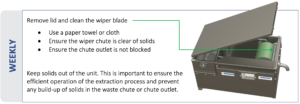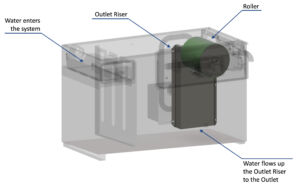CAPTURE FOOD SCRAPS BEFORE THEY LEAVE THE SINK – STOP THEM FROM ENTERING THE GREASE BOSS
The most important action you can take to ensure your Grease Boss performs optimally is to prevent food scraps from leaving the sink and entering the Grease Boss. Install a sink filter and coach staff to remove captured food scraps to the rubbish. Food preparation practices that will help reduce your servicing costs:
- Cutting boards – scrape all residue into the rubbish
- Flour boards/surfaces – scrape flour into the rubbish
- Cooking dishes and customer plates – scrape into the rubbish
- Aioli and similar items – do not empty these food types into the sink
Filter Basket and FOG Capture Container
The filter basket should be cleaned daily. Remove the basket and empty the contents to a waste bin. The disposable FOG collection container should be emptied as required, but typically daily. Remove to a waste bin.

Wiper Blade and Roller
The wiper blade should be cleaned weekly. Remove the lid and wipe across the wiper blade with a paper towel or cloth. Ensure that the wiper chute, which carries the FOG to the collection container, is clear of any solids and that the chute outlet is not blocked. The wiper blade assembly can be removed for additional cleaning by lifting out while sliding toward the front of the unit. Reverse the process to replace.

Clean Out
The Grease Boss must be completely cleaned out by a Service Agent on a regular basis. The clean out frequency will be between 3 -6 months depending upon the food sediment that builds up in the Grease Boss. A build up of food sediment can cause blockages either within the Grease Boss or within the building pipe work.
overflow
If your system is overflowing then the cause is almost certainly a blockage in the Outlet or back flow from other appliances. Water flows through the Grease Boss by gravity as the Outlet is lower than the Inlet. The only way your system can overflow is if the flow of water to the Outlet is compromised by a complete or partial blockage, or water is flowing back into the Outlet from the drainage.
In the cut away of the Grease Boss below, you can see the Outlet Riser and the Roller. The Outlet Riser supports the Roller and provides the path for the separated water to exit the system via the Outlet (situated behind the Outlet Riser). Ensure that there is no food or solids in the Outlet Riser and that the base of the Outlet Riser is clear of sediment. Run water into the Grease Boss and ensure that the water is flowing freely up the Outlet Riser and out of the Outlet.

Enzyme
Replace the enzyme as required – typically every 4 to 6 weeks. Place the enzyme container in safe non-spillable position and place the Auto Dose inlet pump hose into the container to within 10mm of the bottom. The Auto Dose pump is pre-set for dosing.
Clean Out
- Solids will inevitably build up as sediment within the Grease Converter. The grease Converter must be periodically emptied and the sediment removed as part of a regular cleaning cycle.
- Grease traps must be completely cleaned out by a Service Agent on a regular basis. Typically, the clean out frequency is once every 6 months; however, this is dependent on the volume of fat, oil and grease- (FOG) present which is unique to each kitchen. If the volume of FOG is high and the clean out is not completed in a timely manner, FOG will enter the Council’s water network potentially causing blockages Responsibility for the blockages can be traced to your premises and may result in significant cost recovery and fines. We recommend that you complete your first clean out after 3 months, assess the volume of FOG and adjust the frequency of servicing based on this knowledge.
PROGRAMMING THE AUTO DOSE PUMP
The Auto dose pump should be set for:
- Time of day – should be set to the current date and time (the exact time is not important).
- Dispense units – should be set to 120ml for a 170L converter and 200ml for a 250l converter.
- Dispense days – should be set to DAILY.
- Dispense times – should be set for one EVENT. A suitable dispense time for the event would be 1am, however one dispense event per day is all that is required.
Note: To check settings push ENTER to activate the unit and use ENTER to scroll through settings.
To make adjustments
Push ENTER and follow instructions.
- Press PROGRAM then hold for 2 seconds and the display will show PROGRAM.
- Press ENTER twice and the display will show user PIN.
- Press ENTER again and 0000 will appear. Use the left or right cursor to change to 1000 then press ENTER four times. The 1000 will be replaced with ****.
- Press ENTER and the display will show VALID – you can now enter the programmable mode. The indicator light will be flashing.
- Press ENTER to scroll though programme settings and make adjustments as per the instruction manual.
To remove a dispense event
There should only be one dispence event programmed. If additional dispense events have been added then they can be removed with the following instructions.
After scrolling to an EVENT (for example EVENT 2), press PROGRAM and then ENTER. This cancels any dispense event scheduled against that EVENT. This cancellation will not immediately show. To check, go back through the programme sequence and when EVENT 2 appears, and ENTER is pressed to display the event time the display will show NONE.
Water temperature
The MACTRAP polymer grease trap is certified to operate with water temperatures up to 65°C. Higher continuous temperatures may cause sagging.
Venting
The grease trap must be vented off either inlet or outlet, and close to the tank to ensure good ventilation. The top of the tank may also be vented.
Chemicals
The MACTRAP polymer grease trap is tested to handle most kitchen factory type chemicals especially as they are usually diluted with water. However, pure benzene and highly concentrated sulphuric acid in raw form should not enter the grease trap.
Clean out
Grease traps must be completely cleaned out by a Service Agent on a regular basis. Typically, the clean out frequency is once every 6 months; however, this is dependent on the volume of fat, oil and grease- (FOG) present which is unique to each kitchen. If the volume of FOG is high and the clean out is not completed in a timely manner, FOG will enter the Council’s water network potentially causing blockages Responsibility for the blockages can be traced to your premises and may result in significant cost recovery and fines. We recommend that you complete your first clean out after 3 months, assess the volume of FOG and adjust the frequency of servicing based on this knowledge.

